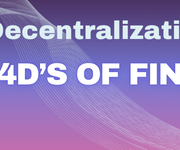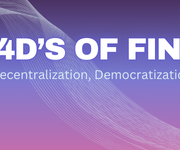If financial services were once a grand theater, then Decentralized Finance (DeFi) has burst onto the scene, shoving the main actors—banks, brokers, and regulators—aside, leaving them scrambling to find their lines. DeFi, which thrives on the ethos of decentralization, is stripping traditional financial institutions of their central roles and putting power squarely in the hands of users. So let’s unravel what’s behind this financial uprising and why everyone from tech enthusiasts to seasoned bankers is watching.
Blockchain Technology: The Backbone of Decentralization
To understand DeFi, we must first look at its technological spine: blockchain. Imagine a public ledger accessible to everyone but controlled by no one—a digital record that’s transparent, tamper-proof, and accessible around the world. That’s blockchain technology in a nutshell. And this ledger doesn’t stop at recording transactions. It supports a myriad of financial activities, from lending and borrowing to trading and staking assets, all without a single middleman.
The Ethereum blockchain stands out as a powerhouse in DeFi, known for its smart contracts—self-executing agreements that operate as trustless, middleman-free transactions. Ethereum’s smart contract functionality has allowed DeFi projects to blossom, making it possible for anyone with an internet connection to access a range of financial services, often without identity checks, credit scores, or endless paperwork.
Smart Contracts: Automated Financial Agreements
Smart contracts are the secret sauce that makes DeFi tick. Think of them as digital agreements that activate automatically when pre-defined conditions are met. Traditional contracts rely on intermediaries—lawyers, escrow agents, banks—to ensure that terms are fulfilled. But smart contracts do away with this need by programming the “if this, then that” conditions right into the blockchain.
Take a platform like Uniswap, which operates on the Ethereum network. Uniswap enables decentralized token swaps, meaning you can trade one cryptocurrency for another directly with another user, without a central exchange or intermediary. How? With smart contracts. The swap happens automatically once the agreed conditions are met. Users maintain control of their funds, transparency is inherent, and costs are kept low by cutting out the middleman.
And yet, there’s a question that still makes traditional bankers sweat: What if the contract malfunctions? Well, that’s where the challenges of decentralization come into play.
DeFi Powerhouses: Ethereum, Uniswap, and Compound
A few DeFi platforms have come to exemplify the power shift that’s happening in finance. Ethereum is the bedrock of DeFi, the platform that introduced the world to smart contracts and decentralized applications (dApps). As the first major blockchain network to allow developers to build and execute applications directly on the blockchain, Ethereum is the core foundation upon which DeFi operates.
Then there’s Uniswap, a decentralized exchange (DEX) that has pioneered the “Automated Market Maker” (AMM) model, allowing users to swap tokens without relying on a centralized exchange. This AMM model enables anyone to provide liquidity (in other words, to be the “bank”), earning fees for facilitating trades. This model removes gatekeepers and lets anyone participate directly in the financial ecosystem.
Compound is another groundbreaking platform, offering decentralized lending and borrowing services. With Compound, users can deposit cryptocurrency and immediately begin earning interest or use it as collateral to borrow against, again without a bank’s involvement. Users can participate directly as lenders or borrowers, setting their own terms. By relying on smart contracts to automate the entire process, Compound has made it possible for peer-to-peer finance to flourish without a single bank in sight.
Why Decentralization Matters
Why are DeFi and decentralization so revolutionary? First, decentralization gives users true ownership of their assets. Traditional banks keep the keys to their vaults, but with DeFi, users hold their own assets, secured by private keys. Transactions are direct, trustless, and transparent, executed on a public ledger without any backroom dealings or intermediaries.
Secondly, decentralization creates financial inclusion. With DeFi, geographic borders vanish. A person in an underserved region can access the same lending, borrowing, and investing opportunities as someone in a financial hub, so long as they have an internet connection. DeFi has also spurred financial innovation, offering services like flash loans (instant, unsecured loans made possible by smart contracts) and liquidity mining (where users earn rewards by providing liquidity).
But let’s not assume decentralization is all unicorns and rainbows. Shaking up the old guard comes with its own complexities and headaches, particularly when it comes to security and regulation.
The Security Conundrum: Trusting Code Over Banks
While DeFi offers autonomy and transparency, it also presents an interesting challenge: who do you trust if there’s a problem? In traditional finance, institutions like banks and credit unions have, at the very least, regulatory frameworks to back them up. If something goes wrong, customers have a course of action. With DeFi, however, users place trust in the code—the programming that makes the system work.
Smart contract bugs or vulnerabilities can spell disaster. In the past, smart contract hacks and exploits have led to millions in losses, making DeFi’s promise of a “trustless” system feel a bit too literal at times. High-profile incidents like the $600 million Poly Network hack have shown that while blockchain technology itself is secure, the applications built on top are still vulnerable to exploits.
And because DeFi is decentralized, there’s no central authority to call for help. When a traditional bank is hacked, regulators step in, and depositors are usually protected. In DeFi, however, users are often left to fend for themselves. This is one of the biggest barriers to widespread adoption, as security issues in DeFi remain a primary concern.
Regulatory Growing Pains: A New Frontier
Regulation is the other elephant in the DeFi room. Traditional financial systems operate within a strict regulatory framework, protecting consumers and ensuring compliance. But DeFi, being global and decentralized, doesn’t easily fit within the typical boundaries of financial oversight. Who’s responsible for enforcing compliance? Who ensures fair play?
For governments and regulators, DeFi is a complex puzzle. DeFi projects operate on anonymous, borderless networks, making it difficult to identify participants, track funds, or enforce legal standards. This freedom from traditional oversight is part of the appeal of DeFi, but it’s also a sticking point for regulators who see DeFi’s rapid growth as a threat to the stability of financial systems.
Global organizations like the Financial Action Task Force (FATF) are beginning to introduce standards to apply to DeFi, but the process is slow, fragmented, and difficult to enforce. Balancing innovation with the need to protect consumers and prevent illicit activities remains an ongoing challenge. And while DeFi enthusiasts tout regulatory avoidance as a feature, not a bug, it’s clear that without some framework, DeFi could struggle to achieve mainstream acceptance.
DeFi: Revolutionizing Finance or Reinventing the Wheel?
Decentralization and DeFi have indisputably changed the face of finance, allowing individuals more autonomy over their financial activities, driving innovation, and posing a real challenge to traditional institutions. The shift from centralized to decentralized systems has sparked a financial revolution—one where users are in control, intermediaries are cut out, and the barriers to entry have been lowered dramatically.
But DeFi’s promises don’t come without caveats. Security concerns and regulatory uncertainty loom large, and while decentralization offers freedom and inclusivity, it also presents new risks. For now, DeFi is still in its Wild West phase: thrilling, full of opportunity, and not without its dangers. Whether DeFi can reach its full potential and go mainstream remains to be seen, but one thing is certain: traditional finance won’t be the same again.
And for the gatekeepers of finance? They might just find themselves standing on the outside, looking in.



